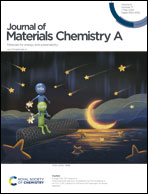NixRh1−x bimetallic alloy nanofibers as a pH-universal electrocatalyst for the hydrogen evolution reaction: the synthetic strategy and fascinating electroactivity†
Abstract
NixRh1–x alloy nanofibers were synthesized by the thermal reduction of single-phase spinel NiRh2O4 nanofibers under a hydrogen gas flow. First, single-phase NiRh2O4 nanofibers were prepared via calcination preceded by electrospinning. The synthetic conditions including the metal precursor ratio in electrospinning solution and calcination temperature were finely optimized to produce single-phase NiRh2O4. Then, the thermal treatment at a temperature ≥200 °C under a H2 gas flow converted NiRh2O4 to NixRh1–x alloy nanofibers. Their electrocatalytic activity for the hydrogen evolution reaction (HER) was examined with voltammetry in alkaline, neutral and acidic media. NixRh1–x alloy nanofibers showed the lowest overpotentials at −10 mA cm−2 and the smallest Tafel slopes in all media, indicating a HER activity superior to those of commercial Pt, pure Rh metal, and Rh-/Ni-based electrocatalysts found in the literature. The reason for the superb activity of NixRh1–x alloys is ascribed to the synergistic effect of the facilitated hydrogen adsorption on alloyed Rh and Ni atoms and the enlarged electroactive areas from the porous uneven nanofiber structure. Considering that only a few pH-universal HER catalysts have been reported, NixRh1–x alloy nanofibers, where expensive Rh is diluted with cheap Ni, present excellent feasibility as a practical and cost-effective HER catalyst.



 Please wait while we load your content...
Please wait while we load your content...